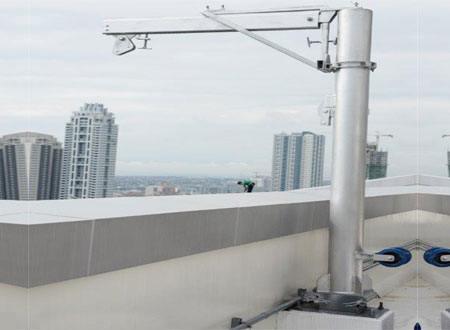In the realm of building maintenance and construction safety, Davit systems have emerged as a crucial innovation, especially in urban landscapes like the Philippines. These systems provide efficient and secure access to building facades, enhancing both safety and productivity across various sectors.
What are Davit Systems?
Davit systems consist of essential components such as an aluminum alloy mast, a jib, and a boom with a rotating collar. These elements facilitate the safe suspension of work platforms, single-user cradles, and bosun’s chairs, offering a versatile solution for accessing building exteriors. Designed to meet stringent safety standards like EN1808 and Machine Directive 2006/42/CEE, Davit systems ensure compliance and reliability in high-risk environments.
Applications of Davit Systems
Construction Sector: In the construction industry, Davit systems play a pivotal role in maintaining facade safety during building erection and finishing stages. They enable workers to access heights with ease, facilitating tasks such as window installation, facade painting, and exterior maintenance. Projects across Manila and other urban centers in the Philippines increasingly rely on Davit systems for their efficiency and safety benefits.
Maintenance Sector: For ongoing building maintenance and repairs, Davit systems offer a superior alternative to traditional methods like scaffolding and ladders. They provide stable platforms for tasks such as cleaning, inspections, and minor repairs without disrupting building occupants or operations below. This makes them ideal for hotels, hospitals, and commercial buildings where uninterrupted access to facades is critical.
Industrial Sector: In industrial settings, Davit systems are essential for accessing machinery and equipment housed in high places. Whether for routine maintenance or emergency repairs, these systems enhance operational safety and efficiency. Industries in the Philippines, from manufacturing to petrochemicals, benefit from the versatility and reliability of Davit systems in maintaining compliance with stringent safety regulations.
Benefits of Davit Systems
Enhanced Safety: Davit systems significantly reduce the risk of falls and accidents compared to traditional access methods. Their stable platforms and secure harnessing mechanisms ensure that workers can perform tasks at height safely. This is crucial for complying with local safety regulations and safeguarding the well-being of personnel.
Efficiency and Productivity: With quick setup times and easy maneuverability, Davit systems minimize downtime associated with accessing building facades. They allow for swift deployment and retrieval, enabling maintenance teams to work efficiently and complete tasks within scheduled time frames. This efficiency translates into cost savings and improved operational productivity for businesses.
Cost-effectiveness: Over the long term, Davit system prove cost-effective by reducing labor expenses and enhancing maintenance efficiency. Their durability and minimal maintenance requirements contribute to lower operational costs compared to renting or erecting scaffolding repeatedly. Businesses in the Philippines can benefit from these savings while ensuring optimal safety standards are met.
Considerations for Implementing Davit Systems
Installation Requirements: Proper installation of Davit systems requires careful consideration of building structures and load-bearing capacities. It is essential to obtain necessary permits and ensure compliance with local regulations governing building facade access and safety.
Maintenance and Training: Regular inspection and maintenance of Davit systems are crucial to their continued safe operation. Training programs for personnel using these systems should cover proper usage, safety protocols, and emergency procedures to mitigate risks effectively.
Takeaway
Davit systems represent a significant advancement in building facade access technology, offering unparalleled safety, efficiency, and cost-effectiveness across diverse sectors in the Philippines. By implementing these systems, businesses can not only enhance workplace safety but also optimize maintenance operations and achieve regulatory compliance effectively.

